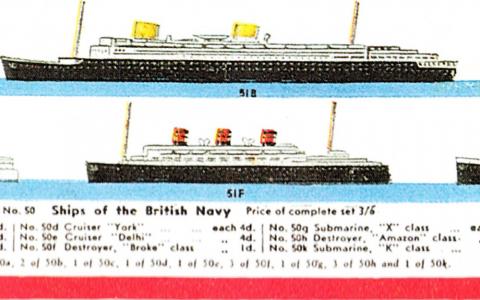--51b Norddeutscher Lloyd 'Europa' (1934-41)
The earliest ship that Meccano chose to model was the German Europa, which was completed in 1930 for the reviving Norddeutscher Lloyd. It was pictured in the early catalogue of 1934 for the first time, no. 51b, as part of the Famous Liners series.
The real ship was fast and efficient, with a low width – length ratio, and a low, sturdy appearance, because of her extremely low funnels. In the gift set box it is the longest model (165 mm), but in reality the Rex (the second longest model, 152 mm) was slightly larger in terms of tonnage.
The choice for T.S. Europa is original, because general attention always seemed to be focused on the first completed sister, T.S. Bremen. Anyway, fortunately for Europa, by this choice this ship got some deserved attention too as, indeed, it was the newest of both! Together with Bremen (1929, 51.656 gross tons), Europa (49.746 gross tons) was the first new liner to dethrone R.M.S. Mauretania as holder of the legendary Blue Riband for the fastest crossing of the Atlantic. This magnificent Cunard four stacker had held the Blue Riband from 1907 on! Neither Aquitania or Olympic, nor German giants like the S.S. Vaterland and S.S. Imperator had managed to do so in the mean time. The Titanic had to pay a high price in 1912 in her effort to beat the Mauretania. Undoubtedly the new fast runningmates were a great pride for the Germans, being the first huge liners after they had to cede – according to the Treaty of Versailles – from their enormous Vaterland (to the USA: Leviathan), Bismarck (to the White Star Line: Majestic) and Imperator (to the Cunard Line: Berengaria). In its turn the Italian S.S. Rex beat the German twins as the fastest transatlantic liner in 1933.
As the smoke from the attractive, fast looking low funnels inconveniently descended to the luxurious upper decks, the two funnels had to be raised considerably, by some 4.5 meters each, very soon after Europa’s first voyage. The plans for producing the Meccano Dinky Toys Famous Liners must therefore have dated from some years before 1934 already, because the modelled Europa shows an 'old-fashioned' appearance, still characterized by the initial low funnels, which only lasted for a very short time.
The lines of the crank liner are nevertheless well represented, demonstrating clearly the extremely low width-length ratio of 1:9.2. The most conspicuous and exciting feature of both the Bremen and the Europa was the innovative use of catapult launched aeroplanes, giving the opportunity to deliver the mail in the harbour of destination many hours before the actual arrival of the fast running ships. When designing the Dinky model this exciting catapult could not be left out of course, so it featured as an emphatically modelled detail on the upper deck. On the 1/1800 scale this tiny detail might normally have been omitted if it were a less characteristic and exciting element.
The ship miraculously survived the war, was taken by the Americans as a troop ship (U.S.S. Europa), and after an extensive refit served for many post-war years as the flag ship of the Compagnie Générale Transatlantique (French Line) under the name Liberté. Finally the modern S.S. France took over in 1961 and the Europa/Liberté was scrapped in 1963.
My final picture below shows the Dinky Europa in front, the Bremen issued by Mercator in the middle and the Mercator Europa in the background. One should best compare the Dinky Europa with the Mercator Bremen, because the Mercator Europa shows this ship in its shape after 1935, with i.a. higher funnels and removed catapult installation. Both the smaller scale and the considerable development in small scale diecast ship modelling are the reason that, when comparing the Dinky Europa with a modern 1/1250 model by Mercator, the difference in faithfulness and detail is dramatic. Still, the difference is also that the Dinky Europa is an exciting contemporary witness of transatlantic transport in the 1930s, whereas the Mercator models are less charming, but better, rather sophisticated later renditions, impossible to be played with.
Many more details about the ship and its history on: https://en.wikipedia.org/wiki/SS_Europa_(1928)
And an interesting maiden trip movie: https://www.youtube.com/watch?v=18EnSm-xZWU
Kind regards, Jan
Jan, thank you for the interesting history and explanation with photos of these special ships. Very special that plane with this catapult post and very nicely illustrated with these photos. Nice to know that.
I personally do not collect ships and planes, but it is always pleasant and educational to read these contributions from you. Fortunately, Meccano Liverpool has modeled a wide collection of ships and aircraft for the real collector.
Kind regards, Jan O.












-073 Land Rover, Horse Box and Horse (1960-67)
DTCAwebsite upgrade 2023
DTCAwebsite upgrade 2023
-105c and 383 4-Wheel Hand Truck (1949-1958)
-105c and 383 4-Wheel Hand Truck (1949-1958)
DTCAwebsite upgrade 2023
DTCAwebsite upgrade 2023
DTCAwebsite upgrade 2023
DTCAwebsite upgrade 2023
DTCAwebsite upgrade 2023
DTCAwebsite upgrade 2023
DTCAwebsite upgrade 2023
DTCAwebsite upgrade 2023
DTCAwebsite upgrade 2023
DTCAwebsite upgrade 2023
DTCAwebsite upgrade 2023
DTCAwebsite upgrade 2023
DTCAwebsite upgrade 2023
--22c Motor Truck (1933-50)
--22c Motor Truck (1933-50)
DTCAwebsite upgrade 2023
DTCAwebsite upgrade 2023
Trailer Caravans
Trailer Caravans
DTCAwebsite upgrade 2023
DTCAwebsite upgrade 2023
DTCAwebsite upgrade 2023
DTCAwebsite upgrade 2023
Trailer Caravans
Trailer Caravans
-138 Hillman Imp (1963-73)
-537 Renault 16 TL
-189 Triumph Herald Saloon (1959-64)
-255 Mersey Tunnel Police Van (1955-61)
DTCAwebsite upgrade 2023